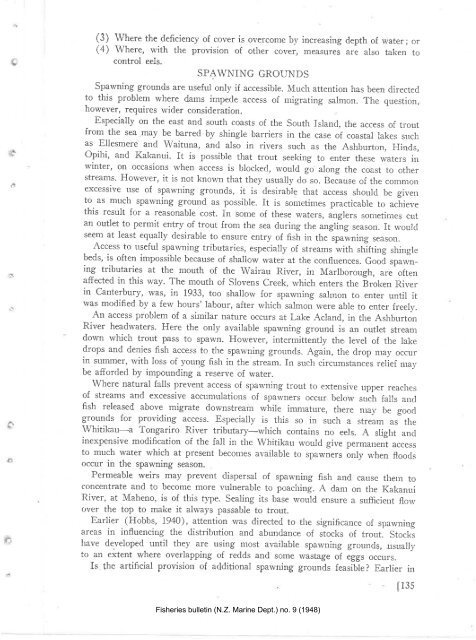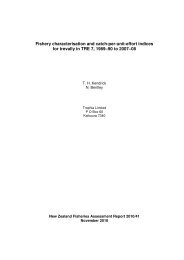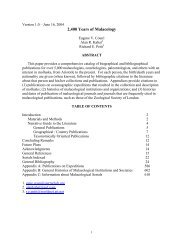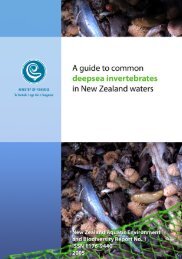N.Z. MARINE DEPARTMENT-FISHERIE,S BULLETIN No. .į
N.Z. MARINE DEPARTMENT-FISHERIE,S BULLETIN No. .į
N.Z. MARINE DEPARTMENT-FISHERIE,S BULLETIN No. .į
Create successful ePaper yourself
Turn your PDF publications into a flip-book with our unique Google optimized e-Paper software.
(3) \A/here the deficiency of cover is overcome by increasing depth of water; or<br />
(4) where, with the provision of other cover, measures are also taken to<br />
control eels.<br />
SPAWNING GROUNDS<br />
Spawning grouncls are useful ,xly if accessible. Much attention has been directecl<br />
to this problen-r where dams impecle access of migrating salmon. The question,<br />
however, requires wider consicleration.<br />
Especially on the east and south coasts of the South Islancl, the access of trout<br />
from the sea may be barrecl by shingle barriers in the case of coastal lakes srrch<br />
as Ellesmere and waituna, and also in rive¡s such as the Ashburton, Hinds,<br />
Opihi, and Kakanui. It is possible that trout seeking to enter these waters in<br />
winter, on occasions when access is blockecl, rvoulcl go along the coast to other<br />
streams' Ifowever, it is not known that they usually clo so. Because of tl-re common<br />
excessive rtse of sparvning grotrncls, it is desirable that access shoulcl be give¡<br />
to. as much spawning ground as possible. It is sometimes practicable to achieve<br />
this result for a reasonable cost. fn sorne of these u,aters, anglers sor-netimes cut<br />
an outlet to permit entry of trout from the sea cluring the angling season. It ,¡,oulcl<br />
seem at least equally desirable to ensure entry of fish i'the spawning season.<br />
Access to useful spawning tritrutaries, especially of streams with shifting shilgle<br />
beds, is often impossible because of shallow water at the confluences. Gooã ,po*rring<br />
tributaries at the mouth of the wairau River, in Marlborough, are often<br />
affected in this way. The mouth of Slovens creek, which enters the Broken River<br />
in canterbury, was, in 1933, too shallow for spawning salmon to enter until it<br />
was modified by a fer,v hours' labottr, after which salmon were able to enter freely.<br />
An access problem of a sin-rilar nature occurs at Lake Acland, in tl-re Ashburton<br />
River headwaters. Here the only available spawning ground is an outlet stream<br />
down which trout pass to spar'vn. Hou,ever, intermittently the level of the lake<br />
drops and denies fish access to tlhe sparvning grouncls. Again, the drop may occr.rr<br />
in sutnmer, with loss of young fish in the stream. In such circumstances relief may<br />
be afforded by impounding a reserve of water.<br />
Where natural falls prevent access of sparvning trout to extensive upper reaches<br />
of streams and excessive accumulations of spawners occur below such falls anrl<br />
ûsh released above migrate downstrear¡ while immature, there nay be goocl<br />
grounds for providing access. Especially is this so in such a strearn as the<br />
\Mhitikau-a Tongariro River tributary-which contains no eels. A slight ancl<br />
inexpensive modification of the fall in the Vy'hitikau woulcl give perma¡ent access<br />
to much water which at present becomes available to spawners only when floocls<br />
occur in the spawning season.<br />
Permeable weirs may prevent. dispersar of spawning fish ancl cause them to<br />
concentrate and to become more vulnerable to poaciting. A clam on the Kakanui<br />
River, at Maheno, is of this typr:. Sealing its base would ensure a sufficient florv<br />
r-,ver the top to make it always passable to trout.<br />
Earlier (Hobbs, 1940), attention rvas directed to the significance of spaw¡ing<br />
a¡eas in influencing the distribution and abundance of stocks of trout. Stocki<br />
have developed until they are using most available spawning gronncJs, .usuall1,<br />
to an extent where overlapping of redds and some wastage of eggs occrlrs.<br />
Is the artificial provision of aclditional spawning grounds feasible? Earlier in<br />
Fisheries bulletin (N.Z. Marine Dept.) no. 9 (1948)<br />
[ 13s







